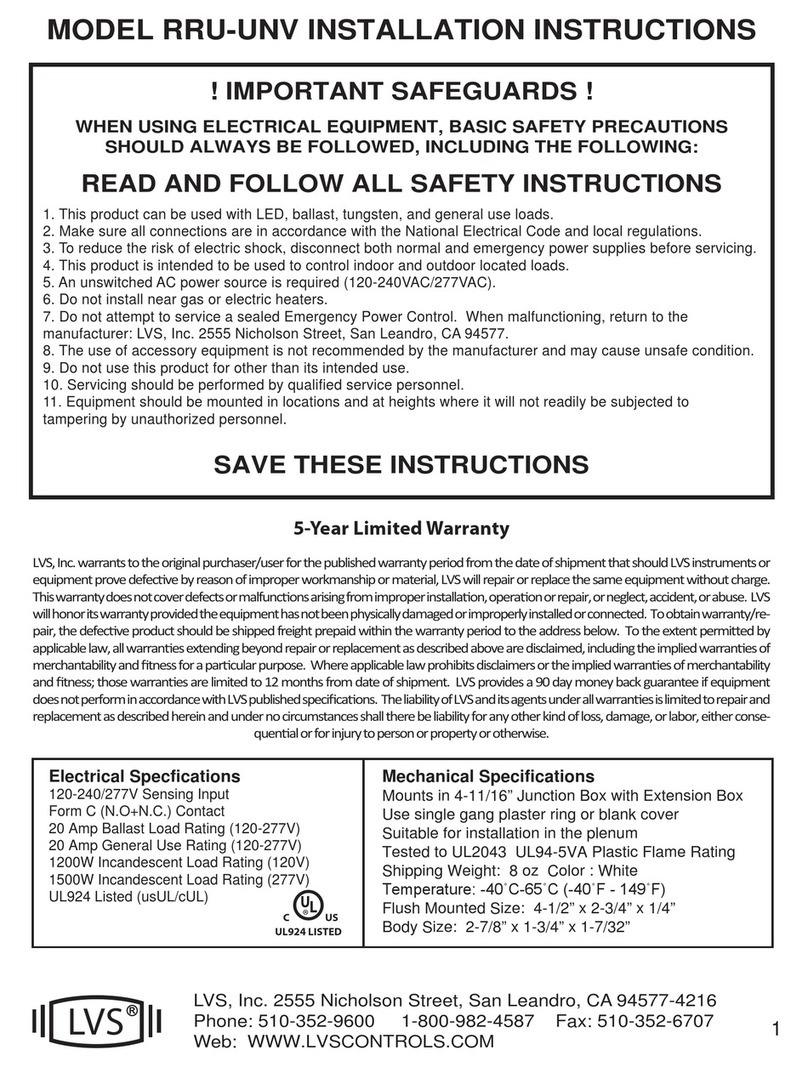
MODEL EPC-2-D-FM INSTALLATION INSTRUCTIONS
1
LVS
LVS, Inc. 2555 Nicholson Street, San Leandro, CA 94577-4216
Phone: 510-352-9600 1-800-982-4587 Fax: 510-352-6707
Web: WWW.LVSCONTROLS.COM
LVS, Inc. warrants to the original purchaser/user for the published warranty period from the date of shipment that should LVS instruments or
equipment prove defecve by reason of improper workmanship or material, LVS will repair or replace the same equipment without charge.
This warranty does not cover defects or malfuncons arising from improper installaon, operaon or repair, or neglect, accident, or abuse. LVS
will honor its warranty provided the equipment has not been physically damaged or improperly installed or connected. To obtain warranty/re-
pair, the defecve product should be shipped freight prepaid within the warranty period to the address below. To the extent permied by
applicable law, all warranes extending beyond repair or replacement as described above are disclaimed, including the implied warranes of
merchantability and fitness for a parcular purpose. Where applicable law prohibits disclaimers or the implied warranes of merchantability
and fitness; those warranes are limited to 12 months from date of shipment. LVS provides a 90 day money back guarantee if equipment
does not perform in accordance with LVS published specificaons. The liability of LVS and its agents under all warranes is limited to repair and
replacement as described herein and under no circumstances shall there be liability for any other kind of loss, damage, or labor, either conse-
quenal or for injury to person or property or otherwise.
5-Year Limited Warranty
1. This product can be used with LED, ballast, tungsten, and general use loads.
2. Make sure all connections are in accordance with the National Electrical Code and local regulations.
3. To reduce the risk of electric shock, disconnect both normal and emergency power supplies before servicing.
4. This product is intended to be used to control indoor and outdoor located loads.
5. An unswitched AC power source is required (120-240VAC/277VAC).
6. Do not install near gas or electric heaters.
7. Do not attempt to service a sealed Emergency Power Control. When malfunctioning, return to the
manufacturer: LVS, Inc. 2555 Nicholson Street, San Leandro, CA 94577.
8. The use of accessory equipment is not recommended by the manufacturer and may cause unsafe condition.
9. Do not use this product for other than its intended use.
10. Servicing should be performed by qualified service personnel.
11. Equipment should be mounted in locations and at heights where it will not readily be subjected to
tampering by unauthorized personnel.
! IMPORTANT SAFEGUARDS !
SAVE THESE INSTRUCTIONS
READ AND FOLLOW ALL SAFETY INSTRUCTIONS
WHEN USING ELECTRICAL EQUIPMENT, BASIC SAFETY PRECAUTIONS
SHOULD ALWAYS BE FOLLOWED, INCLUDING THE FOLLOWING:
Electrical Specfications
120-240/277V Sensing Input
N.C. Output Contact
3 Amp Electronic/LED Load Rating (120-277V)
5 Amp Ballast Load Rating (120-277V)
5 Amp General Use Rating (120-277V)
360W Incandescent Load Rating (120V)
600W Incandescent Load Rating (277V)
Auxiliary N.O.+N.C. Contact (1A/30VDC)
UL924 Listed (usUL/cUL)
Mechanical Specifications
Fixture or Panel Mount
Damp Location Rated
Shipping Weight: 6 oz Color : Black
Temperature: -40˚C-60˚C (-40˚F - 140˚F)
Body Size: 5”x1”x1.25” (125mmx25.4mmx30mm)
U
L
®
UL924 LISTED
C US






















